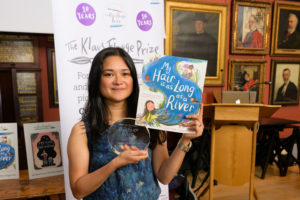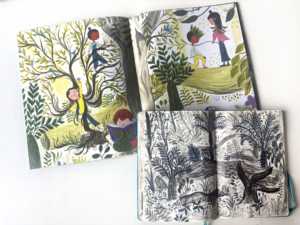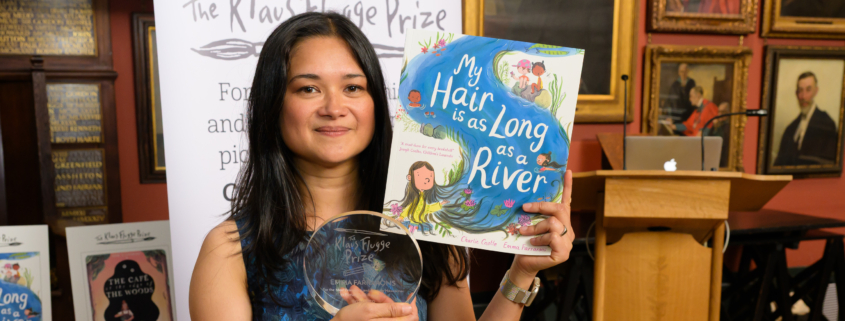Catching up with Emma Farrarons, Winner of the Klaus Flugge Prize
We are delighted to welcome Emma Farrarons, winner of the Klaus Flugge Prize to the blog today, answering questions about winning this prestigious award.
Catching up with Emma Farrarons, winner of the Klaus Flugge Prize

Emma Farrarons has just been announced winner of the 2025 Klaus Flugge Prize, awarded to the most promising and exciting newcomer to picture book illustration. We caught up with Emma, still excited at being named winner, to ask what it means to have won, and what’s next. She also shares sketching tips everyone can follow.
How does it feel be the winner of the Klaus Flugge Prize?
It feels truly extraordinary to be recognised in this way. I’ve always loved picture books and spent my childhood in the library. I studied illustration, focusing on packaging and bookbinding, and spent over 16 years as an in-house designer at Campbell Books and Macmillan Children’s Books.
Eventually, I realised I wanted to illustrate. My illustration wasn’t “picture-booky,” so with guidance from a drawing tutor, I set aside my old way of working and filled sketchbooks with observational drawings of my kids, people in cafés, and everyday moments until a new voice emerged. One observational sketch of my son after school, wearing his bike helmet and eating breadsticks, caught the eye of my former colleagues and prompted them to ask for a sample of a boy with long magical hair.
Winning the Klaus Flugge Prize means so much. Coming full circle from intern to senior designer, and now back as an illustrator, collaborating with former colleagues, my designer Lorna Scobie, editor Grace Gleave, and Charlie Castle’s inspiring text helped me truly find my picture book voice.
How important is it to a debut picture book illustrator to have this recognition?
Recognition is really important. It shines a spotlight on your work, gives a confidence boost, and can open doors to new opportunities. Illustrators often work alone and face impostor syndrome, so being acknowledged by peers and the industry feels especially meaningful.
What are the challenges facing debut picture book illustrators currently?
A significant challenge for debut picture book illustrators is the comparison trap on social media. I know this firsthand. For 16 years, while longing to illustrate, I spent more time admiring other artists than actually drawing, thinking, “I could never do that.” It wasn’t until I drew consistently that I realised the key was focusing on your own work.
What advice would you give to any young person wanting to become an illustrator?
My advice for anyone wanting to become an illustrator is to draw from life. Really look at what you’re drawing, don’t just see. Observational drawing has been my practice for nine years. It’s like going for a run: just a sketchbook, a pencil, and the world to explore.
Start simple with an A5 sketchbook and black-and-white pencils. Focus on tone first, then gradually experiment with inks, pens, greys, and colour. Observational drawing helped me find my voice, feed my memory, and bridge my imagination. Rotate materials, notice little moments, and discover what you love to draw, whether animals, people, interiors, or nature. Over time, you’ll build a bespoke image library to flick through whenever you need a reference. Observational drawing is the foundation of both my memory and imaginary drawing and how my stories spark. Special thanks to my drawing tutor Maisie Paradise Shearring for teaching me everything there is to know about observational drawing.

What will your next picture book project be and what else are you working on right now?
It’s been a busy, creative year. My debut author book, Wands Away: Learning to Fly, came out in August, and I’ve just finished writing the second in the four-book series. The 128-page, highly illustrated two colour early reader follows the adventures of Ramona Spellstar, witch in training. The idea began with a sketch of a little witch travelling to school on a broom, inspired by dropping my kids at forest camp on our cargo bike. What if this bike were a broom? What if this forest were a witch school? I sent it to my agent, and to my surprise, it grew into a four-book deal. Now I’m waiting for layouts and can’t wait to start painting the interiors, experimenting with charcoal, dip pens, watercolour, and speech bubbles.
I’ve also finished a picture book with Rocket Bird Books called I Can’t Sleep, about two brothers’ bedtime adventures, inspired by my own boys who share a room and chatter away until they drift off. On top of that, I’m loving bringing Katie Clapham’s Indie in Disguise chapter book to life for Walker Books, full of humour and heart.
It’s been a wonderfully creative year since My Hair Is as Long as a River was published. I feel incredibly lucky.
My Hair Is as Long as a River is written by Charlie Castle, illustrated by Emma Farrarons and published by Macmillan Children’s Books.
Views expressed do not necessarily reflect those of the Federation.



